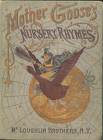|
Nursery Rhymes and other rhymes for small children have been told since the 1200's. While the true origins are not specifically known, there are several sources nursery rhymes from many langauges and cultures. Charles Perrault (1628-1703), the French children's writer, published a book of poems that were a follow-up to his "Tales from My Mother Goose" in 1697. British publisher John Newbery in 1781 (Encyclopedia Britannica) published the first Mother Goose Rhymes derived from these French poems. Prior to that (1744), a collection of nursery rhymes called "Tommy Thumb's Pretty Songbook." was published in London.Thematically, Nursery Rhymes revolve around animals, children fantasy, and magic. Poems usually incude babies and small children, the relationship with a family (often to reasssure that all is well), as well as fanciful fantasy involving animals and others performing strange feats. The earliest rhymes themselves, published as early as the 1200's, are often associated with games, such as counting or name games for the very young. Others created later in the following centuries were adult poems (Encyclopędia Britannica). Similar rhymes made in different regions include "Ladybird, Ladybird" and "Humpty Dumpty" implying there is a single "ancient source" (Encyclopędia Britannica). The "Mother Goose" series published by Isaiah Thomas in 1785 was so popular that in the United States all nursery rhymes are refered to as Mother Goose rhymes.
"Mother Goose." Encyclopędia Britannica. 2006 . Encyclopędia Britannica Online. 29 Aug. 2006
"Nursery Rhyme." Encyclopędia Britannica. 2006 . Encyclopędia Britannica Online. 29 Aug. 2006
Saltman, Judith. "Trade and Plumbcake Forever". The Riverside Anthology of Children's Literature, 6th ed. Houghton Mifflin, 1985. © T. T. Eiland, August, 2006 |
